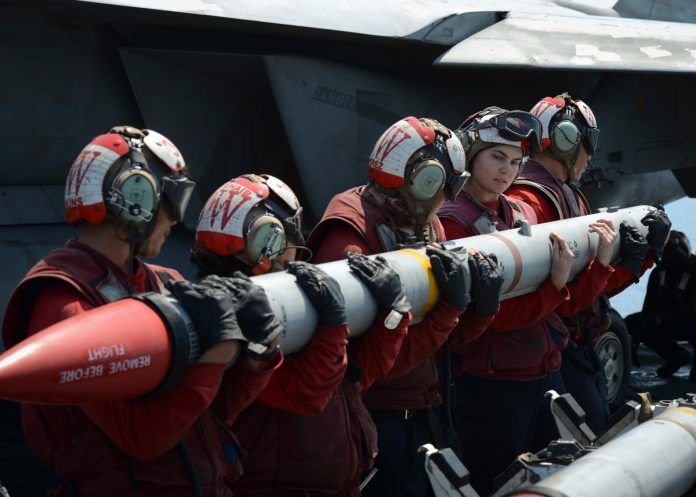The US government has approved a potential $3.5 billion sale of advanced air-to-air missiles to Saudi Arabia. The deal enhances the kingdom’s air defence capabilities and reinforces its long-standing defence partnership with Washington.
The Defence Security Cooperation Agency announced the agreement on 2 May 2025. It includes 1,000 AIM-120C-8 Advanced Medium-Range Air-to-Air Missiles (AMRAAMs), 50 additional guidance sections, support equipment, and related services.
RTX Corporation, based in Tucson, Arizona, will oversee the production and delivery of the missiles. The deal remains subject to congressional approval. It highlights Saudi Arabia’s ongoing efforts to modernise its air force while continuing to rely on US defence systems.
Features and capabilities of the AIM-120C-8
The AIM-120C-8 is the most advanced variant in the AMRAAM family. It is approximately 12 feet in length, weighs 356 pounds, and can reach speeds exceeding Mach 4. Its estimated range of 180 kilometres allows for long-distance engagement of enemy targets.
Equipped with a sophisticated guidance system that combines active radar, GPS correction, and inertial navigation, the missile operates independently after launch. This “fire-and-forget” capability enables pilots to disengage or pursue additional targets.
The AIM-120C-8 also uses Link 16, a two-way data link that provides real-time updates during flight. It carries an 18.1-kilogram high-explosive warhead designed to detonate at the optimal moment via proximity fuse. It is also resistant to jamming, making it highly effective in contested environments.
Upgrades from previous versions
Developed under Raytheon’s Form, Fit, Function Refresh programme, the AIM-120C-8 improves on the AIM-120C-7 with enhanced processing power, better software adaptability, and longer range. These enhancements are made possible by new circuit cards and an extended rocket motor.
The missile can engage targets at extreme angles thanks to its high off-boresight targeting ability. This gives pilots more flexibility in air combat scenarios and increases the missile’s effectiveness against agile or evasive threats.
Operational track record
The AMRAAM series has been adopted by 42 countries and has recorded over 4,900 test firings with 13 confirmed air-to-air kills. Since its introduction in the early 1990s, the missile has been used in various conflicts.
US forces used the AMRAAM in the Gulf War, and in 2015, a Turkish F-16 shot down a Russian Su-24M using the missile. Saudi Arabia has deployed earlier AMRAAM variants to intercept drones and missiles launched by Houthi forces in Yemen.
Pakistan also reportedly used AIM-120C-5 missiles in a 2019 air skirmish with India, downing a MiG-21. These examples show the missile’s versatility across a wide range of combat situations.
Integration with Saudi Arabia’s air force
Saudi Arabia operates multiple platforms compatible with the AIM-120C-8, including the F-15C/D and the upgraded F-15SA. These aircraft are equipped with advanced radar and avionics that support long-range missile engagements.
The Eurofighter Typhoon, also in Saudi service, is being upgraded with new radar systems to enhance compatibility with the AIM-120C-8. Additionally, Saudi AWACS aircraft (E-3 Sentry) provide broader situational awareness to support missile guidance.
Though the kingdom does not currently operate the F-35, the missile is compatible with that platform, potentially allowing for future integration.
Addressing regional security concerns
The missile’s extended range and resilience against electronic warfare provide Saudi Arabia with an advantage in addressing regional threats, including those posed by Iranian forces and their proxies. Its effectiveness against drones and cruise missiles supports efforts to defend vital infrastructure.
Past incidents, including Houthi drone attacks on oil facilities, have demonstrated the need for robust air defence. The AIM-120C-8 offers a proven solution to these evolving threats.
Broader geopolitical implications
While strengthening its ties with the US, Saudi Arabia has also expanded defence cooperation with China, acquiring systems such as the HQ-9 air defence missile and CH-4B drones. These additions provide capabilities in specific roles but may present integration challenges with Western systems due to technical differences.
Despite diversification, the scale of the AMRAAM purchase suggests the US remains Saudi Arabia’s primary partner for advanced defence systems.
Oversight and future considerations
Congress must now review the sale and assess its impact on regional security. Past arms deals have drawn scrutiny over their use in conflict zones like Yemen. The final value of the contract may be lower than the $3.5 billion estimate depending on negotiations.
RTX Corporation will provide not only the missiles but also training and support services. Its Tucson facility continues to play a key role in AMRAAM production, having received contracts for similar systems in recent years.
Looking ahead
Though rivals like Russia’s R-77 and China’s PL-15 offer competing systems, the AMRAAM remains central to many Western-aligned air forces. The US is currently developing the AIM-260 Joint Advanced Tactical Missile, expected to replace AMRAAM models by the late 2020s.
Until then, the AIM-120C-8 provides a critical capability bridge. For Saudi Arabia, it ensures the air force stays ahead of regional threats while maintaining close military cooperation with the US.
